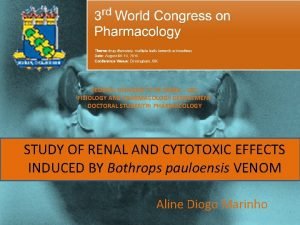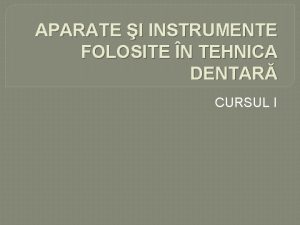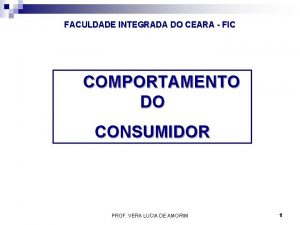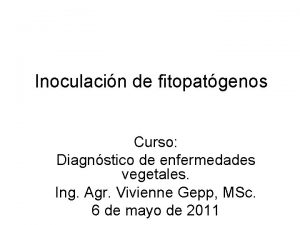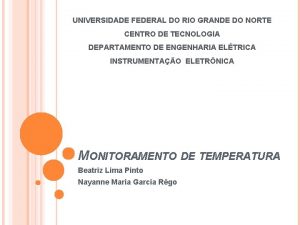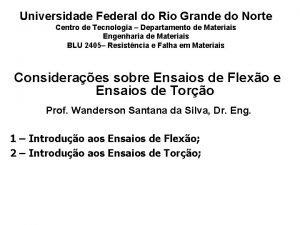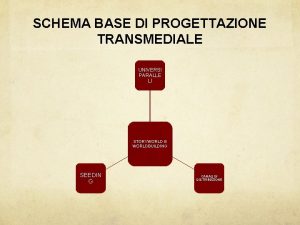FEDERAL UNIVERSI TY OF CEARA UFC FISIOLOGY AND































- Slides: 31

FEDERAL UNIVERSI TY OF CEARA - UFC FISIOLOGY AND PHARMACOLOGY DEPARTMENT DOCTORAL STUDENTIN PHARMACOLOGY STUDY OF RENAL AND CYTOTOXIC EFFECTS INDUCED BY Bothrops pauloensis VENOM Aline Diogo Marinho

INTRODUCTION The World Health Organization: Ø 421, 000 envenomings and 20, 000 deaths occur worldwide from snakebite each year. ØAfrica, Asia and Latin America are the most affected geographical area. ØIn Brazil, approximately 90% of snakebites reported to the Ministry of Health are caused by snakes of Bothrops and Bothropoides genus. Bothrops pauloensis Is a venomous snake, popularly known as “jararaca pintada”, which is found in the Brazilian territory, more commonly in the southwest of the state of Sao Paulo.

INTRODUCTION The venom is composed of a complex mixture of bioactive substances, mainly lectins, metalloproteinases, serinoproteinases, desintegrins, phospholipases, and peptides. This composition may vary according to the snake's age, gender, and region of origin, that are capable of interfering with a variety of physiological processes. Local and systemic Accidents caused by the Bothrops genus in humans are typically associated with rapid edema formation, pain, ecchymosis, hemorrhage, skin necrosis, local myonecrosis and systemic hemolysis, severe coagulopathies, hypotensive shock and acute kidney injury The kidney is highly susceptible to toxins due to its high vascularity. Acute kidney injury is an important complication of Bothrops accidents and is considered the main cause of death in patients that survive the first envenomation effects.

Several studies have been conducted to understand the mechanisms by which the venom leads to ARI

The extrinsic or death receptor pathway and the intrinsic or mitochondrial pathway

METHODS Ø Bp. V was kindly donated by Dr. Marcos H. Toyama, Paulista State University (UNESP). Ø Adult male Wistar rats (260 e 320 g) were fasted for 24 h with free water access. The rats were anesthetized with sodium pentobarbitone (50 mg/kg, i. p). Ø DMEM medium, phenylhydrazone (FCCP), 2, 7 dichlorodihydrofluorescein diacetate (DCFH-DA) kit and 3 -(4, 5 - dimethylthiazol-2 -yl)-2, 5 -diphenyltetrazolium bromide (MTT) were obtained from Sigma Chemical Co. (St. Louis, MO, USA). Ø Annexin. V/FITC Apoptosis Detection Kit was obtained from BD Pharmigen (CA, USA) and tetramethylrhodamine ethyl ester (TMRE) was purchased from Molecular Probes (Eugene, OR, USA). Ø The antibodies against Caspase 3 (#96615) and Caspase 7 (#9492) were obtained from Cell Signaling, while a-tubulin antibody (#T 8203) was obtained from Sigma e Aldrich.

METHODS KIDNEY PERFUSION: modified Krebs-Henseleit solution (albumin 6%p/v)

METHODS Surgical procedure Manitol Kidney in system Identification and dissection of ureter Cannulation of renal artery Cannulation Identification of renal artery

METHODS Experiment 120 min ØUrine and perfusate were colleted at 10 min intervals ØPressure and flow: 5 min PARAMETERS STATISTICAL ANALYSIS • PP • RVR Mean ± SEM • GRF ANOVA followed by Bonferroni post-test and • UF Significance was set at *p < 0. 05. • %TNa+ • % TK+ • %TCl-

METHODS Madin-Darby Canine Kidney (MDCK) epithelial cells Cells were cultivated in RPMI 1640 Medium supplemented with 10% fetal bovine serum (FBS) at 37 C and 5% CO 2. MTT ØCell viability was assessed by MTT (4, 5 -dimetilazil-2 -il)-2, 5 diphenyl tetrazolium). ØCells treated with different concentrations of Vb. P (100; 50; 25; 12, 5; 6, 25 e 3, 12 μg/m. L). A yellow tetrazole, is reduced to purple formazan in living cells

METHODS LDH release ØLDH is a cytosolic enzyme that is an indicator of cellular damage. Released into extracelular space when the plasm embrane is damage. ØCytotoxicity induced by Bp. V (7. 5; 15; 25 and 50 mg/m. L). ØThe amount of formazan product was colorimetrically quantified by spetroscopy.

METHODS Annexin V-FITC and propidium iodide (PI) staining Annexin V : is a protein that binds certain phospholipids called phosphatidylserines, which normally occur only in the inner, cytoplasm-facing leaflet of a cell’s membrane, but become “flipped” to the outer leaflet during the early stages of apoptosis. PI : is the DNA-binding dye molecule PI, which can only enter cells when their membranes are ruptured—a characteristic of both necrosis and late apoptosis. VBp (15; 7. 5 mg/ m. L) for 12 h were stained with annexin. V/propidium iodide (PI) and incubated for 15 min. Cells were analyzed on Flow Cytometer.

METHODS Intracelular Mitochondrial membrane potentiality∆Ψm measurements ØThe cationic TMRE is an indicator that accumulates preferentially in energized mitochondria. ØDepolarized or inactive mitochondria have decreased membrane potential and fail to sequester TMRE. VBp (7. 5 mg/m. L) for 12 h. Cell culture was incubated with TMRE for 30 min at 37 C. Cells were analyzed by Flow Cytometer. Reactive oxygen species (ROS) intracellular measurement ØROS in cells promotes the oxidation of DCFH to yield the fluorescent product, dichlorofluorescein (DCF).

METHODS Caspase 3/7 activity measurements WESTERN BLOT Cells were treated with Bp. V (25; 15; 7. 5 mg/m. L) for 12 h. Caspase expression was determined by western blot.

RESULTS AND DISCUSSION MTT assay The treatment with v. Bp caused decreased on cell viability (6, 25 ug/m. L) with IC 50 of 7, 5 ug/m. L. Proteolytic activity of Bothrops venoms have a significant cytotoxic role in various cell types. FIG 1: . Cytotoxic effect of Bothropoides pauloensis venom on MDCK cells were treated with different concentrations of B. pauloensis venom for 24 h and were evaluated by the reduction in the 3 -(4, 5 -Dimethylthiazol-2 -Yl)-2, 5 -Diphenyltetrazolium Bromide (MTT) salt in cells under Bp. V concentration-curve after 24 h of treatment.

RESULTS E DISCUSSION The results indicated an apparent membrane rupture in MDCK cells at the highest concentrations studied , showing an increase in LDH release. The predominant characteristics of one or other type of cell death are usually determined by intensity and not by specificity of stimulus. FIG 2: Percentage release of the lactate dehydrogenase enzyme of MDCK cells treated under a Bp. V concentration-curve treatment.

RESULTS E DISCUSSION Annexin-PI loading cell analysis demonstrated an increase mainly in AX +/PI - cells at the Gráfico 3: Avaliação domg/m. L, tipo de morte celular envolvido noin efeito v. Bp em células(7. 5 MDCK. concentrations of 7. 5 as well as AX+/PI- cells both de concentrations and Os 15 experimentos foramthe realizados em triplicata (n=3), eand os dados expressos on como porcentagem mg/m. L), suggesting participation of apoptosis late apoptosis Bp. V-induced cell de eventos ± EPM. Para análise estatística, foi utilizado ANOVA, seguido de pós-teste de death, confirming the results showed in MTT and LDH assays.

RESULTS E DISCUSSION Bp. V exposure induces mitochondrial depolarization in MDCK cells Bp. V (7. 5 mg/m. L) caused a left dislocation in TMRE fluorescence after 12 h of treatment. It is believed that the loss of mitochondrial transmembrane potential is due to the opening of the permeability transition pore, a mitochondrial megachannel, which is strongly affected by oxidative stress conditions.

RESULTS AND DISCUSSION ROS generation involvement in cytotoxicity induced by Bp. V in MDCK cells We showed that the amounts of ROS in the Bp. Vtreated MDCK-cells (7. 5 mg/m. L) showed significant right dislocation of the fluorescence peak in the histogram, when compared with the untreated control group. The mitochondria are a major site of generation of free radicals. It is now well established that the generation or addition of ROS can cause cell death either by apoptosis or necrosis, two distinct cell death pathways.

RESULTS AND DISCUSSION • Exposure to large amounts of ROS induces cell death by necrosis, while less severe oxidative stress leads to apoptosis; • The increased levels of ROS leads to the oxidation of lipids, proteins and nucleic acids by increasing the collapse ΔΨm; • The response to oxidative damage of mitochondria is an important pathway in early apoptosis.

RESULTS AND DISCUSSION Bp. V (15 and 25 mg/m. L) treatment induced activation of caspase 3 and caspase 7 These data indicate apoptotic involvement in Bp. Vinduced cell death in these cells. Several studies have confirmed the involvement of Bothrops and Bothropoides venom components in apoptosis (Díaz et al. , 2005; Laing and Moura-da-Silva, 2005; Mora et al. , 2006; Tanjoni et al. , 2005; Alves et al. , 2008; Jimenez et al. , 2008; Morais et al. , 2013; Mello et al. , 2014).

RESULTS AND DISCUSSION We observed a decrease in all the analyzed parameters at both concentrations used (3 and 10 mg/m. L) when compared to control perfused kidneys. The infusion of Bp. V (10 mg/ m. L) significantly decreased the perfusion pressure (PP; Fig. A) and renal vascular resistance (RVR; Fig. B) at 90 and 120 min; however, at the lowest venom concentration (3 mg/m. L), only renal vascular resistance decreased at 120 min of perfusion, when compared with the control group. Bp. V induced alterations in rat isolated kidney. Effects of Bothrops pauloensis venom on perfusion pressure (A) and vascular renal resistance (B). The data represent the mean ± S. E. M of at least three independent experiments. *Significantly different from control group (One-way analysis of variance and Bonferroni post-test, *p < 0. 05).

RESULTS AND DISCUSSION At both assessed concentrations, urinary flow (UF; Fig. D)decreased at 90 e 120 min and glomerular filtration rate (GFR; Fig. C) decreased at 60, 90 and 120 min. Bp. V induced alterations in rat isolated kidney. Effects of Bothrops pauloensis venom on glomerular filtration rate (C) and urinary flow (D). The data represent the mean ± S. E. M of at least three independent experiments. *Significantly different from control group (One-way analysis of variance and Bonferroni post-test, *p < 0. 05).

RESULTS AND DISCUSSION • Bothrops venom cause hypotension: Morais et al, 2013. ; Evangelista et. al. , 2010; Braga, 2006; HAVT et. al. , 2005; Barbosa et. al, 2002 and Miller. , 1990. • Phospholipase activity can produce renal vasodilatory prostaglandins. • Poisoning by B. Asper and B. jararaca induced significant increases of TNF, IL-1, IL-6, IL-10, IFN-δ and NO (PETREVICH et al. , 2000); • Participation of NO (a vasodilator agent). • The reduction in PP and RVR by poison B. pauloensis may have caused ischemia in some areas of the kidneys and promote indirect kidney damage tubule cells. • Direct cytotoxic action on poison in renal tubular cells may also be responsible for these results.

RESULTS AND DISCUSSION At 3 and 10 mg/m. L, the percentage of sodium (% TNa; Fig. 4 E) and chloride tubular transport (%TCl; Fig. G) decreased significantly at 60, 90 and 120 min of perfusion. The percentage of potassium tubular transport (%TK; Fig. 4 F) decreased at 60, 90 and 120 min at the highest concentration. Effects of Bothrops pauloensis venom on sodium, potassium and chloride (E, F, G) tubular transport percentage. The data represent the mean ± S. E. M of at least three independent experiments. *Significantly different from control group (One-way analysis of variance and Bonferroni post-test, *p < 0. 05).

RESULTS AND DISCUSSION • Bothrops venoms are extremely harmful to the renal tubules. • A study in which experimental inhibited NO production, resulting in decreased renal irrigation and decreased sodium transport, indicating that this mediator stimulates excretion of sodium. • The very accumulation of proteins in the tubules may be preventing the reabsorption of Na +. • The reduction of electrolyte excretion points to possible direct action of VBP in the renal tubules.

CONCLUSIONS Our results showed direct toxicity of Bp. V on renal cells and the alterations in rat isolated kidney. The elucidation of these cell death mechanisms will allow interfering with their signaling molecular pathways at some point and will contribute to the knowledge of kidney pathophysiology of envenomation.

CONTRIBUTORS ALICE MARTINS MARCOS HIKARI TOYAMA ISABEL CRISTINA RAMON PESSOA D NYA LIMA CLARISSA PERDIGÃO GUSTAVO PEREIRA MAR ORZÁEZ ROBERTA JEANE RAFAEL JORGE ALISON SILVEIRA PEDRO LUIS SILVIA HELENA Profa. Dra. Helena Serra Azul Monteiro



THANKS
 Fisiology
Fisiology Spatula ceara tehnica dentara
Spatula ceara tehnica dentara Cultura de massa
Cultura de massa Fovee palatine
Fovee palatine Antônio caio dos santos
Antônio caio dos santos Ipva ceará
Ipva ceará Ceará
Ceará Gmail
Gmail Ficha catalográfica ufc
Ficha catalográfica ufc Dqafq ufc
Dqafq ufc Ufc 4 controls
Ufc 4 controls Consumers 2-7
Consumers 2-7 Rust airfield radiation
Rust airfield radiation üfc
üfc Hematocitómetro
Hematocitómetro Ufc scif
Ufc scif Rotenone
Rotenone Chapter 13 federal and state court systems
Chapter 13 federal and state court systems State and federal constitutions
State and federal constitutions National government vs federal government
National government vs federal government State and federal constitutions
State and federal constitutions Rothschild and federal reserve
Rothschild and federal reserve The federal reserve and you video question answers
The federal reserve and you video question answers Onrr compliance
Onrr compliance Federal agency for medicines and health products
Federal agency for medicines and health products Federal and state court systems
Federal and state court systems Universidade federal do rio grande do norte
Universidade federal do rio grande do norte Universidade federal do rio grande do norte
Universidade federal do rio grande do norte Gsa vehicle leasing guide
Gsa vehicle leasing guide Federal reserve jurisdiction
Federal reserve jurisdiction Federal district court map
Federal district court map Federal court system structure
Federal court system structure
